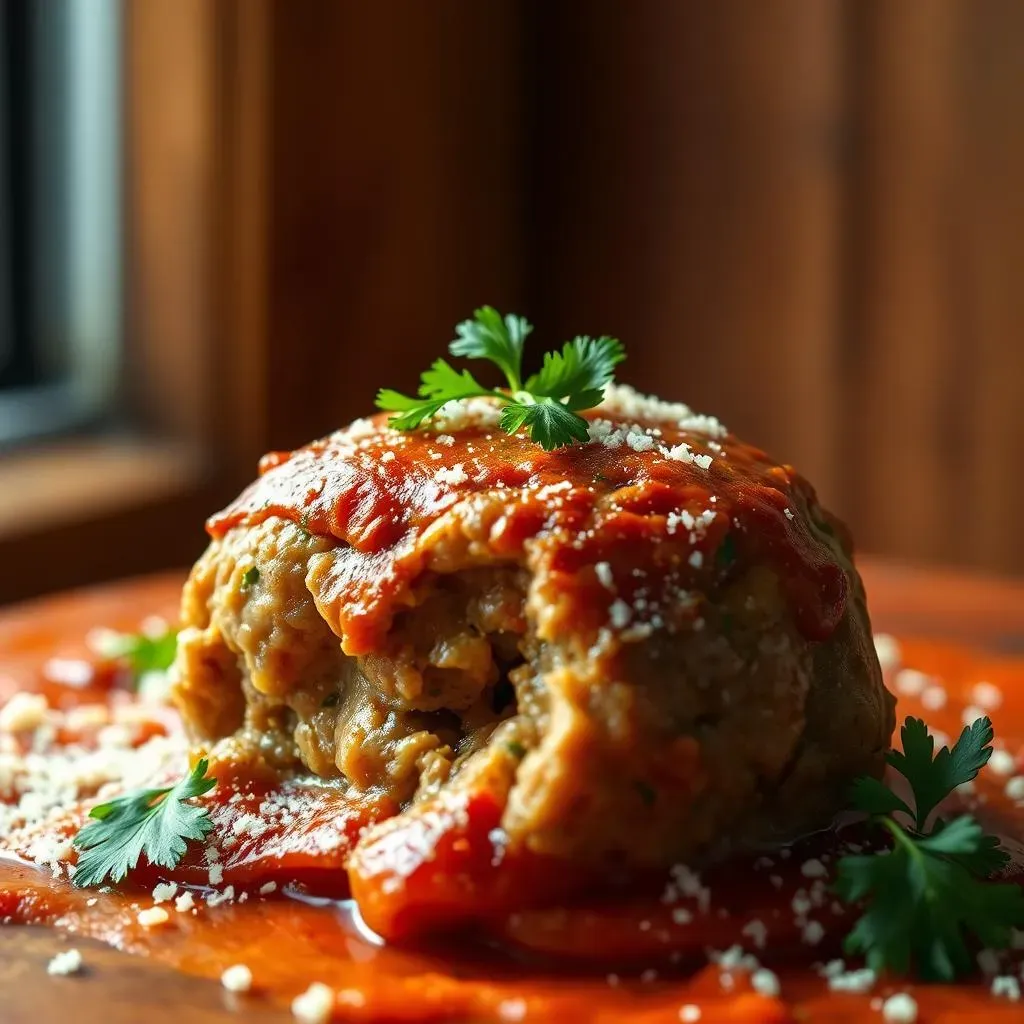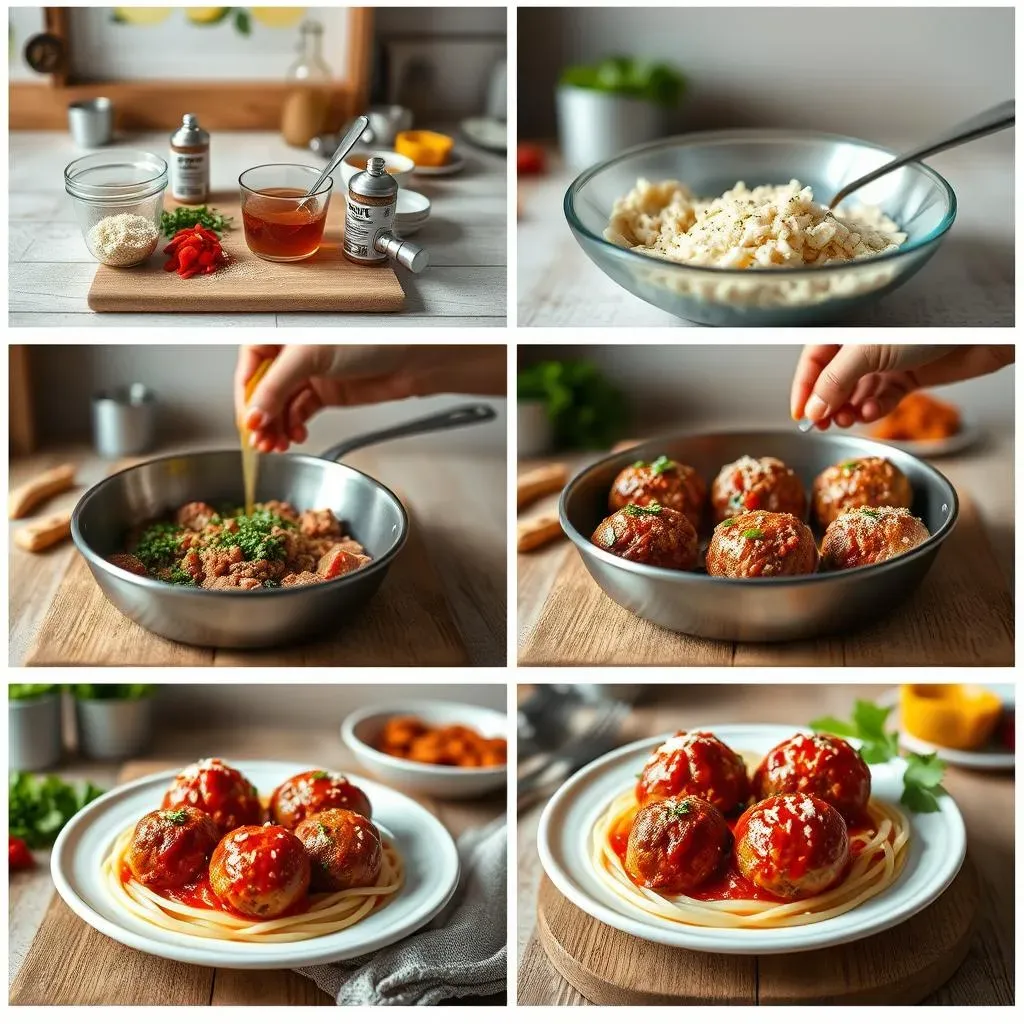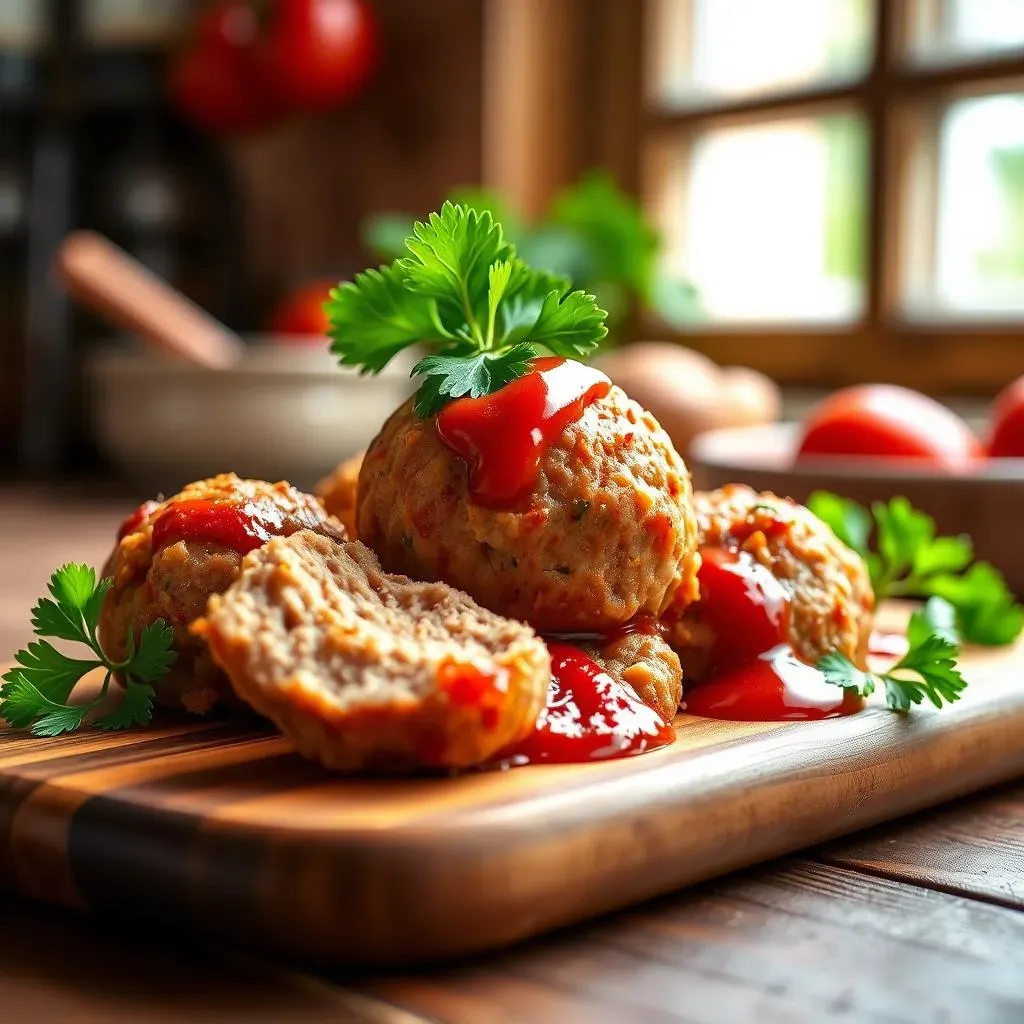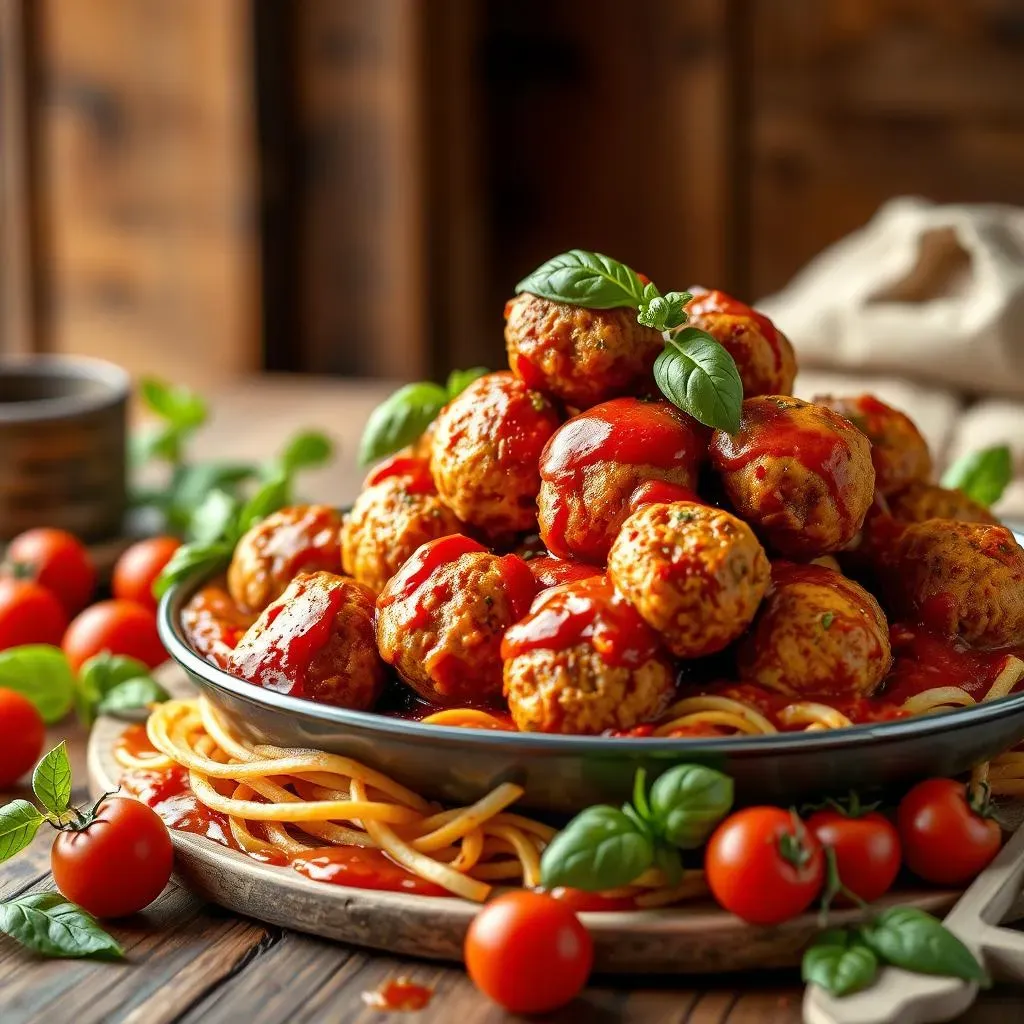Forget standing over a hot stove, splattering oil everywhere! This italian meatball recipe baked is about to revolutionize your meatball game. We're talking juicy, tender, flavorful meatballs without the fuss and mess of frying. Baking is the secret to evenly cooked meatballs that are perfect for pasta night, meatball subs, or even as a tasty appetizer.
Why Bake Your Italian Meatballs? The Superior Method

Why Bake Your Italian Meatballs? The Superior Method
Less Mess, More Flavor
let's be real. Frying meatballs can be a total disaster. Oil splattering everywhere, a greasy stovetop, and the constant worry of burning yourself? No thanks! Baking offers a much cleaner and more convenient alternative. You simply arrange your meatballs on a baking sheet, pop them in the oven, and let the heat do its magic. No babysitting required, and cleanup is a breeze.
But it's not just about convenience. Baking also allows the meatballs to cook more evenly. The dry heat circulates around each meatball, ensuring they're cooked through without burning on the outside. Plus, you avoid the extra fat and calories that come with frying, making this a slightly healthier option. It's a win-win!
Healthier and Easier
Think about it: when you fry meatballs, they're essentially swimming in oil. That oil gets absorbed, adding unnecessary fat and calories to your meal. Baking, on the other hand, allows the meatballs to cook in their own juices, resulting in a leaner and more flavorful final product. You're still getting that delicious, savory taste, but without the added grease.
And let's not forget the ease factor. With baking, you can prepare a large batch of meatballs all at once, without having to stand over a hot stove for hours. This is perfect for meal prepping or when you're feeding a crowd. Just imagine: perfectly cooked, flavorful meatballs, ready to be enjoyed with your favorite pasta sauce, and all with minimal effort. What's not to love?
Key Ingredients for the Perfect Italian Meatball Recipe

Key Ingredients for the Perfect Italian Meatball Recipe
The Meat: Your Foundation for Flavor
Alright, let's talk meat! The foundation of any great meatball is, well, the meat. While you can use a single type of ground meat, I find that a blend creates the most complex and delicious flavor. My go-to is a combination of ground beef and ground pork. The beef provides that classic meaty taste, while the pork adds richness and moisture. You can also throw in some ground veal if you're feeling fancy, but beef and pork will do the trick just fine.
Now, pay attention to the fat content. You don't want super lean meat, or your meatballs will end up dry and crumbly. Aim for around 80% lean and 20% fat. This will ensure that your meatballs stay juicy and tender during baking. Trust me, the fat is your friend here!
Binders and Seasonings: Holding It All Together
Next up, we need something to bind all that meat together and add some extra flavor. This is where breadcrumbs, eggs, and cheese come in. Breadcrumbs act as a sponge, soaking up the meat juices and helping the meatballs retain their shape. I prefer Italian-seasoned breadcrumbs for that classic Italian flavor, but you can also use plain breadcrumbs and add your own blend of herbs and spices.
Eggs are another essential binder, helping to hold everything together and adding moisture. And then there's the cheese! Romano or Parmesan cheese adds a salty, savory note that complements the meat perfectly. Don't skimp on the cheese – it makes a big difference!
Finally, let's talk seasonings. Garlic is a must, of course. I like to use fresh garlic, minced finely, for the best flavor. Fresh parsley adds a pop of freshness and color. And don't forget the salt, pepper, and a pinch of red pepper flakes for a little kick. Feel free to experiment with other herbs and spices, like oregano, basil, or thyme, to create your own signature meatball flavor.
Ingredient | Purpose | Notes |
|---|---|---|
Ground Beef | Main flavor, meaty texture | 80/20 blend recommended |
Ground Pork | Richness, moisture | Can substitute with veal |
Italian Breadcrumbs | Binder, flavor | Can use plain with added seasonings |
Eggs | Binder, moisture | Use large eggs |
Romano/Parmesan Cheese | Flavor, saltiness | Freshly grated is best |
Garlic | Flavor | Freshly minced |
Fresh Parsley | Flavor, freshness | Finely chopped |
Salt, Pepper, Red Pepper Flakes | Seasoning | Adjust to taste |
The Secret Ingredient: Love!
I know it sounds cheesy, but it's true! The best meatballs are made with love and attention to detail. Don't rush the process. Take your time to mix the ingredients thoroughly, but don't overmix, or the meatballs will be tough. Gently shape the meatballs into uniform sizes, and handle them with care. And most importantly, have fun! Cooking should be enjoyable, so put on some music, pour yourself a glass of wine, and get ready to make some amazing meatballs.
StepbyStep Guide to Baking the Best Italian Meatballs

StepbyStep Guide to Baking the Best Italian Meatballs
Get Your Mise en Place Ready
Before you even think about touching the meat, let's get organized. "Mise en place" is a fancy French term that basically means "everything in its place." It's a chef's secret to smooth cooking, and it applies perfectly to meatball making. Start by gathering all your ingredients and measuring them out. Mince your garlic, chop your parsley, and grate your cheese. This way, when you're ready to mix, everything is at your fingertips, and you won't be scrambling around looking for that one missing spice.
Mixing the Magic
Now for the fun part! In a large bowl, combine all your ingredients: ground meat, breadcrumbs, eggs, cheese, garlic, parsley, salt, pepper, and red pepper flakes (if using). Gently mix everything together with your hands. Be careful not to overmix, as this can make the meatballs tough. You want everything to be just combined. A light touch is key here!
I like to use my hands for this because it allows me to feel the texture of the mixture and ensure that everything is evenly distributed. Plus, it's kind of therapeutic, in a weird way. Just make sure your hands are clean!
Shaping and Baking
Once your mixture is ready, it's time to shape the meatballs. I like to use a cookie scoop to ensure that they're all uniform in size, but you can also just use your hands. Gently roll the mixture into balls about 1.5 to 2 inches in diameter. Place the meatballs on a baking sheet lined with parchment paper. The parchment paper prevents the meatballs from sticking and makes cleanup a breeze.
Now, pop the baking sheet into a preheated oven at 375°F (190°C) and bake for about 20-25 minutes, or until the meatballs are cooked through and browned on the outside. The internal temperature should reach 165°F (74°C). You can use a meat thermometer to check for doneness.
Step | Action | Notes |
|---|---|---|
1 | Gather Ingredients | Measure and prepare everything |
2 | Mix Ingredients | Gently combine, don't overmix |
3 | Shape Meatballs | Uniform size, about 1.5-2 inches |
4 | Bake | 375°F (190°C) for 20-25 minutes |
5 | Check Doneness | Internal temp of 165°F (74°C) |
Rest and Enjoy
Once the meatballs are done, remove them from the oven and let them rest for a few minutes before serving. This allows the juices to redistribute, resulting in a more tender and flavorful meatball. Serve them with your favorite pasta sauce, on a meatball sub, or as a tasty appetizer. Enjoy!
Tips and Tricks for a Flavorful Italian Meatball Recipe Baked to Perfection

Tips and Tricks for a Flavorful Italian Meatball Recipe Baked to Perfection
Don't Be Afraid to Experiment with Flavors
so you've got the basic recipe down, but now it's time to get creative! One of the best things about meatballs is that they're incredibly versatile. Don't be afraid to experiment with different flavors and ingredients to create your own signature meatball. Want a little heat? Add more red pepper flakes, or even a pinch of cayenne pepper. Love garlic? Throw in an extra clove or two. The possibilities are endless!
Consider adding some finely chopped vegetables to your meatball mixture. Onions, carrots, and celery can add moisture and flavor, while also sneaking in some extra nutrients. Just make sure to chop them very finely so they don't affect the texture of the meatballs. Sun-dried tomatoes, olives, or even a splash of balsamic vinegar can also add a unique twist.
Secrets to Keeping Meatballs Moist and Tender
Nobody wants dry, crumbly meatballs! The key to keeping them moist and tender is to add plenty of moisture to the mixture and avoid overcooking them. As we discussed, using meat with a higher fat content is crucial. But you can also add other ingredients to boost the moisture level. Soaked bread is a classic trick. Simply soak some bread in milk or water, squeeze out the excess liquid, and add it to the meatball mixture. The bread will help retain moisture and keep the meatballs nice and juicy.
Another tip is to avoid overmixing the ingredients. Overmixing develops the gluten in the meat, which can make the meatballs tough. Mix everything gently until just combined, and then stop. And finally, be careful not to overbake the meatballs. Use a meat thermometer to check for doneness, and remove them from the oven as soon as they reach an internal temperature of 165°F (74°C). They'll continue to cook slightly as they rest, so it's better to err on the side of slightly undercooked than overcooked.
Tip | Description |
|---|---|
Use high-fat meat | 80/20 blend is ideal |
Add soaked bread | Soak bread in milk or water |
Don't overmix | Mix gently until just combined |
Don't overbake | Check internal temperature |
Baking Sheet Savvy
The type of baking sheet you use can also affect the outcome of your meatballs. A light-colored baking sheet will reflect heat, while a dark-colored baking sheet will absorb heat. If you're using a dark-colored baking sheet, you may need to reduce the baking time slightly to prevent the meatballs from burning on the bottom. Lining your baking sheet with parchment paper is always a good idea. It prevents the meatballs from sticking, makes cleanup easier, and helps to distribute the heat evenly.
Another trick is to use a wire rack on top of your baking sheet. This allows the hot air to circulate around the meatballs, resulting in more even cooking and browning. It also helps to prevent the meatballs from sitting in their own juices, which can make them soggy. If you don't have a wire rack, you can simply drain off any excess liquid halfway through baking.
Serving and Storing Your Delicious Baked Italian Meatballs

Serving and Storing Your Delicious Baked Italian Meatballs
Serving Suggestions: Beyond Spaghetti
so you've got a batch of perfectly baked Italian meatballs. Now what? Sure, you could just toss them with some spaghetti and call it a day (and hey, that's a perfectly valid option!). But let's think outside the pasta box for a minute. These meatballs are incredibly versatile and can be used in so many different ways. How about a meatball sub, piled high with marinara sauce and melted mozzarella cheese? Or maybe some meatball sliders for a party appetizer? You could even chop them up and add them to a pizza or use them as a topping for polenta.
Don't forget about the sides! A simple salad with a vinaigrette dressing is a great way to balance out the richness of the meatballs. Roasted vegetables, like broccoli or Brussels sprouts, are another healthy and delicious option. And if you're feeling fancy, you could even serve them with a creamy risotto or some garlic mashed potatoes. The possibilities are endless!
Storing Leftovers: Keeping the Flavor Alive
If you're lucky enough to have leftovers (and let's be honest, sometimes that's a big "if"), you'll want to store them properly to keep them fresh and flavorful. The best way to store baked Italian meatballs is in an airtight container in the refrigerator. They'll keep for up to 3-4 days. Make sure to let them cool completely before storing them, as this will help prevent condensation from forming, which can make them soggy.
When you're ready to reheat the meatballs, you have a few options. You can microwave them, but be careful not to overcook them, or they'll become dry and rubbery. A better option is to reheat them in a saucepan with some marinara sauce. This will help to keep them moist and flavorful. You can also reheat them in the oven, but again, be careful not to overcook them. Just pop them in a preheated oven at 350°F (175°C) for about 10-15 minutes, or until they're heated through.
Storage Method | Instructions | Shelf Life |
|---|---|---|
Refrigerator | Airtight container, cool completely | 3-4 days |
Freezer (Cooked) | Airtight container or freezer bag | 2-3 months |
Freezer (Uncooked) | Freeze individually, then bag | 2-3 months |
Freezing for Future Feasts
Want to make a big batch of meatballs and save some for later? Freezing is your friend! You can freeze both cooked and uncooked meatballs. To freeze cooked meatballs, let them cool completely, then place them in an airtight container or freezer bag. They'll keep in the freezer for up to 2-3 months. When you're ready to use them, simply thaw them overnight in the refrigerator and reheat as described above.
To freeze uncooked meatballs, place them on a baking sheet lined with parchment paper and freeze them individually until they're solid. This will prevent them from sticking together in the freezer. Once they're frozen solid, transfer them to a freezer bag or airtight container. They'll keep in the freezer for up to 2-3 months. When you're ready to cook them, you can bake them straight from frozen, but you may need to add a few extra minutes to the baking time. Just make sure they reach an internal temperature of 165°F (74°C) before serving.
The Last Bite: Mastering Your Italian Baked Meatball Recipe
So, there you have it – the ultimate guide to baking Italian meatballs that are guaranteed to impress. From the ease of preparation to the healthier cooking method, this italian meatball recipe baked is a winner on all fronts. Whether you're a seasoned cook or just starting out, these tips and tricks will help you achieve meatball perfection every single time. Now, go forth and bake some deliciousness, and prepare to be amazed at how simple and satisfying it is to create these classic comfort food favorites in your own kitchen. Enjoy!